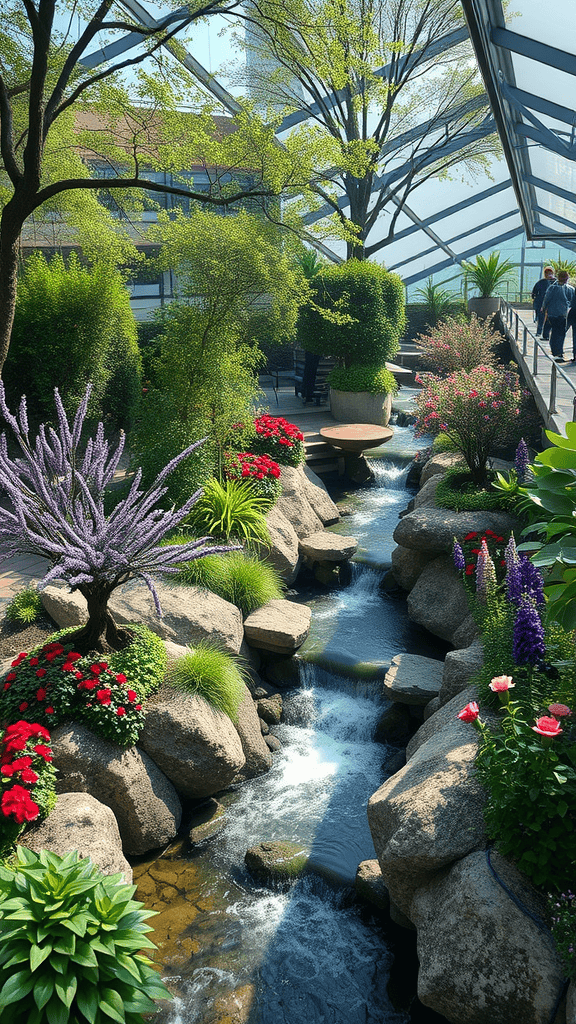Understanding the Concept of a Flow Garden and Its Benefits
Have you ever heard of a flow garden? It’s an innovative gardening concept that combines beauty and functionality. A flow garden is designed to manage water efficiently while creating a harmonious and vibrant space. Instead of traditional gardening methods, flow gardens focus on the natural flow of water, allowing plants to thrive in conditions that mimic their native habitats.
The primary goal of a flow garden is to enhance water management in your landscape. This method utilizes the natural movement of water to nourish the plants. By capturing and directing rainwater, flow gardens reduce the amount of runoff and promote healthy plant growth. You might wonder how this works in practice.
In a flow garden, plants are strategically placed to ensure optimal water absorption. The layout often includes a variety of native plants that are well-suited to the local climate. These plants have adapted to the natural rainfall patterns, making them hardy and low maintenance. Here are some key aspects to understand:
- Water Management: Flow gardens are designed to collect rainwater. This system helps prevent flooding and erosion by directing water to areas where it can be absorbed by plants.
- Diverse Plant Selection: Native plants form the backbone of flow gardens. They require less water and are adored by local wildlife, attracting beneficial insects and birds.
- Soil Health: The garden’s design encourages healthy soil. With proper drainage and moisture, the soil remains rich in nutrients, supporting plant growth.
- Environmental Impact: Flow gardens contribute to improved water quality. By filtering pollutants and sediment, they help keep water sources cleaner.
You can create a flow garden in your backyard, even if space is limited. Start by assessing the natural flow of water on your property. Identify areas where water tends to pool or drain. These areas can be transformed into beautiful flow gardens that manage water effectively.
When planning your flow garden, consider incorporating features like swales or rain gardens. Swales are shallow ditches that collect water, while rain gardens are designed to soak up excess water. Both work hand-in-hand to create a balanced environment for your plants.
Choosing the right plants is essential for a successful flow garden. You want to select varieties that thrive in wet and dry conditions. Some excellent options include:
- Wildflowers: Native wildflowers are beautiful and attract pollinators.
- Sedges: These grasses thrive in wet soil and provide great ground cover.
- Rushes: Another water-loving plant, rushes bring height and texture to the garden.
- Flowering Shrubs: Native shrubs can provide structure and seasonal interest.
Beyond water management and aesthetics, flow gardens carry numerous benefits for homeowners and the environment. They help reduce the need for chemical fertilizers and pesticides, as native plants are typically more resilient to pests. A flow garden can serve as a natural habitat for various wildlife, promoting biodiversity.
Moreover, learning about the natural ecosystem is exciting for families and kids. Engaging with a flow garden allows you to teach children about the importance of water conservation and environmental stewardship while enjoying the wonders of nature together.
One might think that maintaining a flow garden is complicated, but that’s not the case. With native plants, much of the maintenance is minimal. Regular monitoring, occasional weeding, and proper mulching are key to keeping your garden healthy and thriving. Watering may be necessary during extreme drought periods, but the natural design of the garden usually minimizes this need.
A flow garden into your landscape isn’t just a trend; it’s a sustainable practice that supports a healthy ecosystem. From its water-efficient design to its role in enhancing biodiversity, a flow garden is a smart choice for anyone looking to create a beautiful outdoor space while helping the environment.
By understanding the concept of a flow garden, you can make informed decisions about your gardening practices. It’s a rewarding way to connect with nature while enjoying all the benefits of a vibrant, sustainable space!
Practical Tips for Designing and Maintaining Your Flow Garden
Creating and sustaining a flow garden can be a rewarding experience. By harmonizing nature with design, you can cultivate a beautiful outdoor space that promotes relaxation and well-being. Here are some practical tips to help you design and maintain your flow garden effectively.
Understanding the Basics of a Flow Garden
A flow garden is designed to guide the eye and spirit through a lush, deliberate arrangement of flora. Think of it as a garden that draws you in and encourages leisurely exploration. To start, consider your garden’s layout. A winding path often enhances the flow, creating a sense of movement and discovery. Sloping areas can add depth, allowing you to showcase various plants at different levels.
Selecting the Right Plants
Choosing the right plants is crucial for establishing the desired atmosphere. Here are considerations for selecting plants:
- Native Species: Embrace your local ecosystem by including native plants. They typically require less maintenance and are better suited for your garden’s conditions.
- Variety of Heights: Use plants of varying heights to create depth. Tall plants can serve as a backdrop, while shorter flowers can add color and texture in the foreground.
- Color Palette: Decide on a color scheme. Harmonious colors can create serenity, while contrasting colors add vibrancy. Think about seasonality to maintain interest throughout the year.
- Seasonal Interest: Choose plants that bloom in different seasons to ensure a continuously blooming garden. Combining evergreens with perennials and annuals offers year-round appeal.
Creating Pathways
Pathways are essential for enhancing flow. They can guide visitors and promote exploration. Consider the following:
- Curved Paths: Use gentle curves instead of straight lines. Curved paths evoke a sense of pathway exploration and mystery.
- Natural Materials: Use stone, gravel, or mulch for a more organic feel. Avoid synthetic materials that may clash with the natural beauty of your plants.
- Width: Ensure the paths are wide enough for easy navigation, especially if you plan to have a seating area along the way.
Water Features
A water feature can enhance the flow of your garden immensely. The sound of trickling water adds tranquility and can attract birds. Consider these options:
- Small Ponds: A small pond with aquatic plants can create a focal point. Make sure it’s balanced with your garden’s overall design.
- Fountains: A fountain can add a charming element without taking up too much space. The sound of flowing water will enhance the serene atmosphere.
- Birdbaths: Attract local wildlife and add visual interest with decorative birdbaths.
Lighting for Ambiance
Lighting is a key component in making your flow garden usable into the evening. Here are some tips:
- Path Lighting: Use solar-powered path lights to illuminate walkways without overwhelming the senses.
- Spotlights: Highlight focal points like sculptures or unique plants with strategic spotlights to draw attention.
- String Lights: Hang string lights in trees or along pathways for a cozy feel during gatherings.
Regular Maintenance Tips
To keep your flow garden looking its best, regular maintenance is key. Consider these practices:
- Pruning: Prune your plants regularly to maintain their shape and health. Remove dead or diseased branches promptly.
- Mulching: Apply a layer of mulch to maintain soil moisture and suppress weeds.
- Fertilizing: Assess your soil health. A bi-annual application of organic fertilizer can provide necessary nutrients for thriving plants.
- Seasonal Cleanups: In preparation for each changing season, clear away debris and assess plant health, replacing any that have struggled.
Designing and maintaining a flow garden can transform your outdoor space into a peaceful retreat. With thoughtful planning and ongoing care, your garden can be both beautiful and functional, offering a serene spot for relaxation and contemplation.
Conclusion
Creating a flow garden can be a transformative experience that enhances both your outdoor space and your well-being. Understanding the concept of a flow garden allows you to harness the natural beauty of your surroundings while promoting relaxation and mindfulness. Whether it’s through vibrant flowers, soothing sounds of water, or the gentle rustle of leaves, every element plays a crucial role in crafting a serene sanctuary.
When designing your flow garden, consider the layout carefully. Integrate pathways that encourage exploration and mindfulness, and choose plants that not only thrive in your climate but also resonate with your personal aesthetic. Regular maintenance ensures that your garden flourishes, allowing you to fully enjoy the calming benefits it offers. Simple practices like mulching, watering at the right times, and seasonal pruning can keep your garden looking its best.
By creating a space filled with beauty and tranquility, you actively promote mental well-being. The act of nurturing your plants can offer a meditative experience, while the beauty of your garden provides a peaceful escape from the hustle and bustle of daily life. Embracing the principles of a flow garden enriches your connection to nature, making the outdoor experience more fulfilling.
Ultimately, a flow garden not only beautifies your environment but also nurtures your spirit. Whether you’re a seasoned gardener or just starting out, the journey to create and maintain your flow garden will be a rewarding adventure full of joy and harmony. Immerse yourself in this creative process, and enjoy the many benefits that come with cultivating your own piece of paradise.
As an Amazon Associate, I earn from qualifying purchases.

